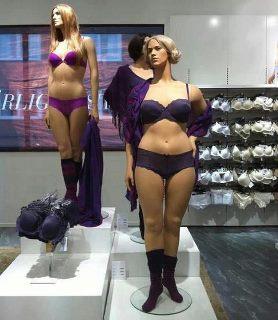Realistic mannequins cause a stir in Sweden

Will transforming mannequins from stick-thin to more realistic sizes boost sales?
One H&M clothing store in Sweden decided to find out, after replacing slender mannequins with more robust, realistic versions that flaunt their curves.

As reported on Yahoo!'s Shine, two pictures of the larger mannequins were posted online before gaining viral traction. Now uploaded within Facebook group Women's right news, the image has gained over 50,000 likes and 16,000 shares. The comments are generally positive, with one poster noting:
"Anybody saying these mannequins encourage obesity or look unhealthy, you have a seriously warped perception of what is healthy."
The more realistic proportions, however, have also raised some interesting questions. By changing the size of the model, are we allowing more women to better imagine themselves in clothes -- as the average size of a U.S. woman is now a size 14 -- and therefore improve sales, or will the business itself be met with criticism from the fashion world, as previous attempts to introduce plus-sized models have suffered?
Modern day mannequins have faced criticism for suggesting that the ideal is between a size 4 to 6. Gap, for example, has been criticized for using bone-thin models to promote skinny jeans, and in 2007, a British official demanded that London stores use mannequins that represented a wide range of shapes and sizes.
A mannequin's function, from WW1 to today, is ultimately to influence shoppers to buy. Perhaps those that reflect the size and shape of today's average woman, rather than an unhealthy, fantasy ideal, will create a more positive shopping atmosphere, and thus encourage women to shop more often, stay longer, and spend more.
Related:
- Without models and celebrities, how do you reinvent perfume?
- Bionic mannequins spy on you as you shop
- Smartphones: The future’s tape measure
- Misfit Shine: Adding a sexy sheen to wearable health
- Swap-o-Matic: Consumerism to cast-offs
- Security cameras track shopper preferences?
This post was originally published on Smartplanet.com